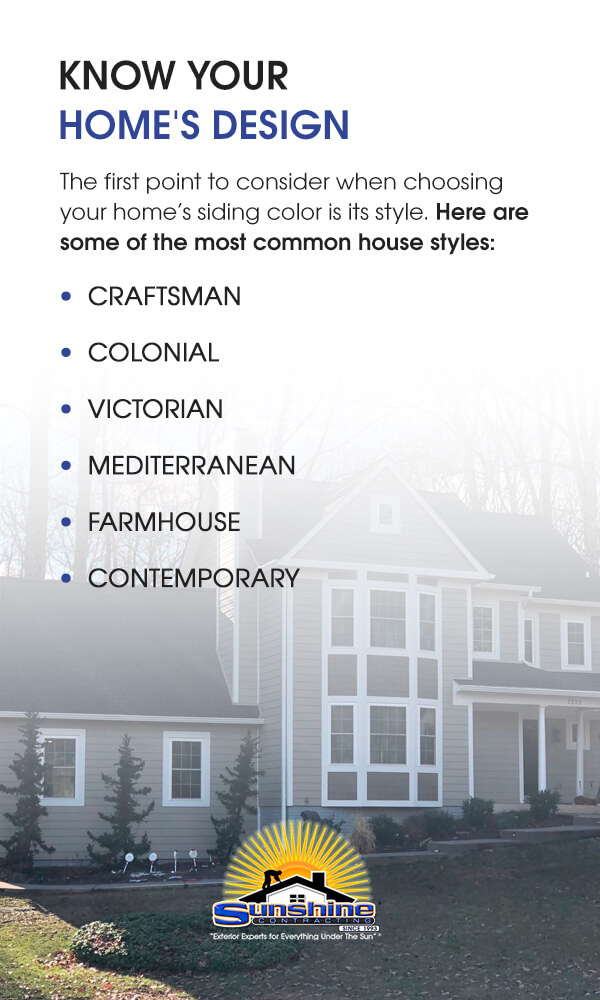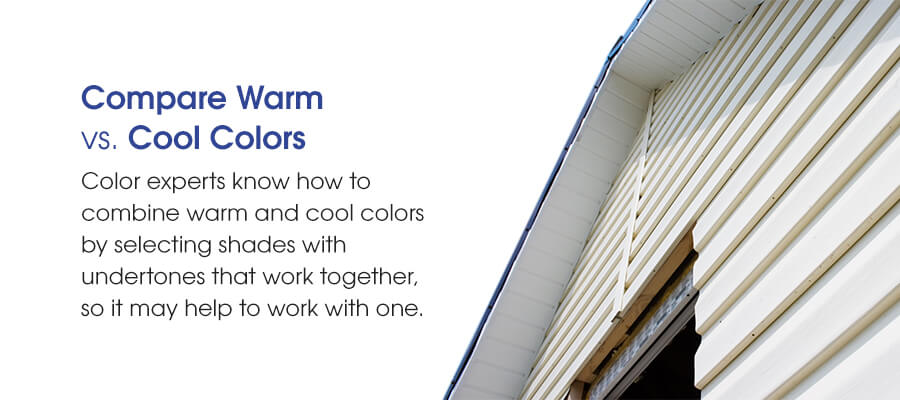How to Choose the Best Siding Color for Your Home
A home’s exterior is its face, revealing its style and warmth to the outside world. Therefore, choosing the right siding color for your home is important in making a great first impression and designing a home you love.
This guide to how to choose the best siding color for your home will walk you through the top things to consider when making your selection. Below, we cover various architectural, color and design rules to follow so you can select a siding color you’ll be happy with for years to come.
1. Know Your Home’s Design
The first point to consider when choosing your home’s siding color is its style. Whether you’re building a new home or renovating an existing one, it’s crucial to identify the style category your home falls under. There’s a wide array of different home styles, as preferences have greatly evolved over time and across different regions.
Here are some of the most common house styles and how to select the best colors for these designs:
- Craftsman: These homes have recognizable architectural features, with gabled roofs that typically have exposed wooden beams or rafters. Originally designed to showcase hand-made wooden design details, craftsman homes typically have wood or wood-like siding that coordinates with the overall artisanal feel. Since the craftsman style emphasizes natural elements, it’s common to find these homes with earthy-hued siding in colors like tan or sage.
- Colonial: Originating in the late 1600s, colonial homes are known for their strong geometric and symmetrical shapes, with a focal point on the front door. Featuring prominent windows paired with shutters, colonial homes often feature light-colored siding with darker accents, helping these details stand out. Traditional colonial homes range in siding color from white to beige to blue to red.
- Victorian: With a romantic architectural style, Victorian homes often resemble dollhouses. These houses typically have ornate detailing along the porch, gables and other trim accents. Victorian house siding often features playful and charming colors, including bold purples or blues.
- Mediterranean: As the name suggests, Mediterranean homes are influenced by the architecture found in France, Spain, Greece and Portugal. Classic Mediterranean design elements include sun-bleached exteriors with red tile roofs and enclosed doorways or balconies that provide shade. Common siding colors on Mediterranean homes include oranges, yellows, reds and browns on one end of the spectrum, and bright whites and blues on the other.
- Farmhouse: The past decade has seen the resurgence of farmhouse architecture, with many designers modernizing this house style by making clean and refined design tweaks. Today’s updated farmhouse look emphasizes simplicity, focusing more on a neutral color palette of whites, ivories and light grays across the exterior siding, trim and accents.
- Contemporary: These properties are recognizable by their asymmetrical, low-pitched roofs that coordinate seamlessly with the home’s siding, window trim and other accents. A popular aesthetic for modern contemporary homes is to make the home blend in with nature, emphasizing a more sustainable approach to homebuilding. As a result, many of today’s contemporary homes will pull in a natural color palette with wood-colored roofs, siding and accents.
2. Match the Neighborhood’s Style
If you reside in a tightly packed neighborhood, you may want to make updates to your home that complement the houses on your street. Choosing a siding color that clashes with the theme of the neighborhood can interrupt the street’s cohesion. Instead, carefully consider the flow of your street and how your home can integrate with the overall feel.
This may not be easy in neighborhoods that have been infilled over time, where new homes sprung up over the course of several decades, all following that era’s trend. In this case, you can’t go wrong with choosing a modern, contemporary neutral palette, whether in cool or warm tones. Find the nearest home or homes that are closest in style to yours and try to coordinate with those while also respecting the colors of your direct neighbors’ homes.
If you’re making siding color updates in a newer neighborhood where all the homes were built around the same time, it can be much simpler to determine an overall color scheme and work with it. Don’t be afraid to use non-neutrals, including bold or rich colors, if the immediate neighboring homes allow for it.
If you’re having trouble matching your siding to your neighborhood, browse our siding portfolio to get inspired.
3. Think About Current Trends
Whether you’re building a new custom home or giving your current home an update, it’s smart to consider some of the latest color trends to ensure your home is up-to-date with the latest styles. Having your siding follow a contemporary color trend gives your home a polished feel and can help increase your resale value, as most home buyers want to buy homes requiring minimal updates.
Below are some of the popular house siding colors and color schemes in 2021:
- Bold colors: In recent months, more homeowners are opting for vibrant color combinations, using their home’s exterior to showcase statement-making hues. Some homeowners are looking to break away from traditional color pairings to enjoy bold blues and greens and charcoals and black.
- Pastels: Along the same lines as trying out bold colors, many homeowners are ready to bring back a cheerful vibe to their neighborhood by choosing siding in friendly pastels — pale yellow, green and blue help to reflect homeowners’ joy and pride in their homes.
- Monochromatic color scheme: Another new siding color option is the monochromatic look. To achieve it, select one primary color that will be used throughout the siding and on the trim and accent pieces. The accent color can vary slightly in shade to add a bit of contrast, but overall the look remains seamless.
- High-contrast: Like the monochromatic style, an opposing trend is also on the rise — high-contrast exteriors are becoming more popular, especially in contemporary- and farmhouse-style homes. With the high-contrast look, you choose one dark color and one light color, segmenting each across your home’s exterior. Popular high-contrast color combinations can include classic black and white, charcoal and light gray or dark brown and sand.
4. Compare Warm vs. Cool Colors
When thinking about how to choose from different home siding color options, the best idea is to familiarize yourself with the basics of color theory. As the set of guidelines designers use to select colors, color theory has important rules to follow in order to choose color siding options that will look great for years to come.
One important idea in color theory is warm vs. cool colors. The color wheel, which is the visual representation of all colors, is split into two sections. One side represents cool colors, and the other side represents warm colors. If you take the basic colors of the rainbows, cool colors consist of green, blue and purple, while warm colors consist of red, orange and yellow. Where it gets tricky is when colors start to blur the line between cool and warm, such as with magenta ? a purplish red color.
When selecting the color of your house siding, the basic rule is to use colors that cooperate together on this cool vs. warm spectrum. In general, you’ll want to use siding colors that are either all warm or all cool. However, color experts know how to combine warm and cool colors by selecting shades with undertones that work together, so it may help to work with one.
5. Select Accent Colors
When selecting house siding colors, it’s essential to develop a complete color scheme that includes your accents. A full color scheme can include one to two different siding colors and one or more accent colors. These additional colors help define a house’s architectural details, drawing the eye to certain focal points and highlighting the unique shape and geometry of the home.
The accent points on a home’s exterior include:
- Shutters
- Window trim
- Front doors
- Columns and pillars
- Porch railings and steps
- Exposed beams and rafters
- Eaves and gables
Depending on the color trend you’re using for your home’s exterior, you may choose an accent color in either complementary or contrasting colors. The former colors are ones that oppose each other on the color wheel. An example of a complementary color combination is red and green. Alternatively, contrasting colors are two colors that differ from each other in shade or tint. An example of contrasting colors is black and white.
One of the best ways to create a beautiful color scheme for your home’s exterior is to choose a contrasting color for your shutters. Various siding and shutter color combinations help tell your home’s color story, enhancing its curb appeal.
6. Look at Landscaping Styles
One of the often-overlooked ways to choose the best color siding for homes is to assess the landscaping. It’s critical that your home and its surrounding environment coexist harmoniously, not clash with each other. That’s especially important when doing home renovations and upgrading existing siding. Therefore, you’ll need to consider some of the existing style factors about your landscaping and hardscaping in order to integrate your home’s style.
Some factors to consider about landscape style when choosing your house siding color include:
- Landscape material: A home’s landscaping acts as the canvas for the rest of the yard. Whether your yard is covered in a blanket of rich green lawn or you’ve installed drought-friendly gravel, you want to make sure that your siding color coordinates with the most prominent yard color.
- Greenery: If your landscape features an abundance of lush green trees and shrubs, you may be inclined to opt for a more organic color combination that honors the prominence of your yard’s natural influences. Conversely, if your home is surrounded by a more subdued and stark landscape, a striking combination is encouraged.
- Flowers: Brightly colored gardens can be balanced out by more muted or neutral home design colors. If your landscaping consists of few flowers or smaller, earthy shrubs, you might choose to lighten things up with a bolder exterior.
Achieve a cohesive design by selecting a siding color that enhances your yard’s natural beauty.
7. Consider How Lighting Affects Colors
How our eye perceives color is affected by the amount of light available. In other words, colors can look dramatically different at different times of the day depending on the amount of direct sunlight your home receives.
One of the best ways to choose between options for your home’s siding color is to obtain samples of your top siding color choices and place them on one side of your home. Check back throughout the day to see how each color looks. Make notes comparing the different colors and whether they became darker, lighter or lost their depth as the sun pattern changed.
Swatching allows you to try the color before you make a commitment so you can be absolutely sure of your decision before investing time and money in your new siding color.
8. Coordinate With Your Roof Color
Whether you’re building a new home or upgrading your existing house, it’s a good idea to consider your roof material and color. Some housing styles, such as craftsman, colonial and contemporary, tend to feature roof architecture prominently as part of the overall design. The eye will be drawn toward the roof more in some designs than in others. The more prominent your roof, the more important it is to coordinate your siding and accent colors with it.
Depending on the color scheme you’re going for, you may choose a siding color that contrasts against a darker roof shade. An example would be white siding with a charcoal roof. Alternatively, if you’re designing your home to achieve a monochromatic look, you might choose a siding color that’s in low contrast to your roof color, such as charcoal siding and a black roof.
Contact Sunshine Contracting for Help Selecting Your Siding Color
Choosing a new siding color for your home can be an exciting process, giving homeowners an opportunity to explore different color schemes and find the one that expresses their style. The right color combination can beautify your home, enhance its curb appeal and even increase your resale value. With so many different colors and palettes to consider, homeowners need to turn to a reliable expert for help making the ideal selection.
One of the best ways to choose siding color options for your home is to consult Sunshine Contracting. With over 28 years of industry experience, we have the knowledge and expertise to help make your siding project a success. The Sunshine Contracting team can help you choose the right siding and accent color combinations that take into account your home’s architecture, your neighborhood, landscaping and many more factors.
Sunshine Contracting offers:
Learn more about our siding installation services in the Fairfax County, Virginia area. Contact us online or call 703-935-4663 to schedule a free quote today.






